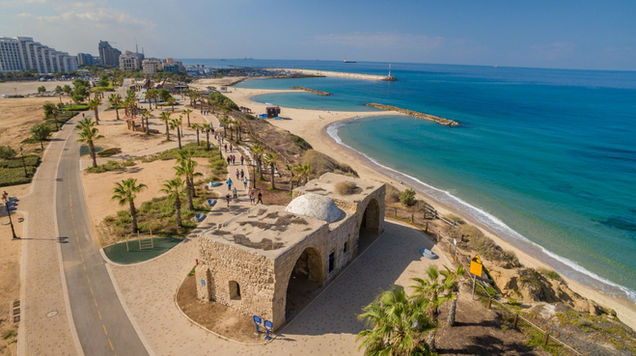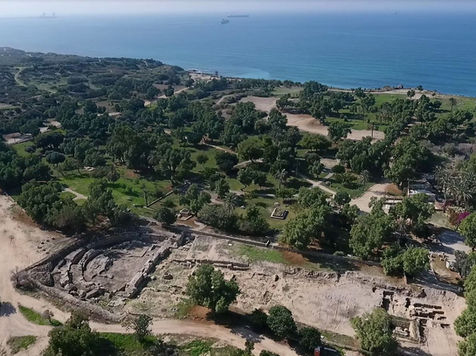

Biblical Ashkelon
Photo Gallery
Places of Interest
Ashkelon
Location
1. Ashkelon is located just south of Ashdod. It also is on the Mediterranean Ocean and was one of the five cities of the Philistines.
Historical Background
1. South of the modern city of Ashkelon is a large National park with ruins of the ancient city. It has a history of 4,000 years and was a port city located on the main trade route from Egypt to the North. It started as a huge fortified Canaanite city and continued as a Philistine city, turning into a thriving commercial center and independent city during the Hellenistic and Roman periods.
2. The origin of the name Ashkelon appears to come from the word “shekel,” denoting a measure of weight – a fitting name for a commercial port city.
3. The specific name Ashkelon is mentioned in the Egyptian execration texts of the 19th century BC, and it appears again in other, later Egyptian inscriptions.
4. Ashkelon has the world's oldest Canaanite Gate in the world which dates back to almost 4000 years ago.
5. Ashkelon also played a part in the battle against the Assyrians. Zedaka, the ruler of Ashkelon, joined the rebellion of Hezekiah, king of Judah (701 BCE). In response, Sennacherib, king of Assyria, took over the city and replaced the treacherous ruler with one of his subjects.
6. The city changed hands many times after that, as Greeks and Maccabees and Romans and Muslims and Crusaders all had their turn. Some think that Herod the Great was born in Ashkelon; the fact is that he did build a palace and aqueduct there.
7. The Babylonian king Nebuchadnezzar, who came to the city later, was less merciful. In 604 BC, he deported Aga, the last Philistine king of Ashkelon, and razed the city to the ground.
8. During the Persian period, Ashkelon was a prosperous commercial city under the auspices of the port cities of Tyre and Sidon.
9. It was used as a border fortress by the Crusaders from around 1100-1191 AD. However, Saladin destroyed the Ashkelon fortress in AD 1191 (during the end of the Crusader Period). As a result, the city lay in ruins for a century. This basically ended its history.
10. After this time, a town was built by Arabs near the original site of Ashkelon and called Al-Majdal.
11. Today, a large national park beautifully preserves the history of ancient Ashkelon. It's well worth a visit if you have a chance to see it.
Places of Interest
1. The Canaanite Gate
2. The Rampart
3. Medieval Walls
4. The Roman Basilica
5. St. Mary Viridis Church
6. Wells: Within the national park, there are 67 wells, the majority of them from the Byzantine period.
7. Natural sand dunes and landscapes.
Ashkelon in the Bible
1. Joshua and the Israelites conquered Ashkelon in the conquest of the Promised Land (Josh. 13:3), and it was allotted to Judah, who then occupied it (Judg. 1:18).
2. One of the golden tumors (emerods) that was returned with the Ark of the Covenant by the Philistines was from Ashkelon.
1 Samuel 6:17: Now these are the gold tumors which the Philistines returned as a guilt offering to the Lord: one for Ashdod, one for Gaza, one for Ashkelon, one for Gath, and one for Ekron.
3. Askelon is mentioned by David when, after Saul and Jonathan die, he lamented and mourned over them.
2 Samuel 1:19-20: Your beauty, Israel, is slaughtered on your high places! How the mighty have fallen! 20 Tell it not in Gath, proclaim it not in the streets of Ashkelon, or the daughters of the Philistines will rejoice, the daughters of the uncircumcised will celebrate.
4. Ashkelon was also denounced by Jeremiah (Jer. 25:20, 47:5–7), Zephaniah (2:4–7), and Zechariah (9:5).
Faith Lesson from Ashkelon
1. God used the Philistines to punish the Israelites because they turned away from Him and followed false gods. In the same way, God often uses people in our lives to get us back on track with the Lord when we stray.
2. God judged the city of Ashkelon and held them accountable for their sins. In the same way, God will hold those who reject Him accountable today as well. We will all stand before God and give an account for our lives.
3. What about us? Are we right with God and letting our lights shine to a world that needs God and His salvation through Jesus Christ?
Travel Guide Book
664 Pages
Bible Companion Book
654 Pages
Biblical Sites
Israel Overview Tour of All Biblical Sites
Jerusalem Sites
Chapel of the Ascension: Ascension & Return of Christ
Death, Burial, Resurrection of Christ
Garden of Gethsemane: Church of All Nations
Herod/Pilate's Palace: Trial of Jesus
House of Caiaphas: Peter's Denial of Christ
Kidron Valley: Judgment of God
Pater Noster Church: Lord's Prayer, Olivet Discourse
Church
Prophecy, Proof the Bible Is True: Mount of Olives
Southern Stairs/Davidson Archaeological Site
The Old Testament Feasts & Jesus
Zedekiah's Cave & Solomon's Quarry
Sea of Galilee Sites
Capernaum: Jesus' Ministry Base
Gennesaret, Ginosar: Jesus Boat
Boat Ride: Jesus Walks on Water, Calms the Sea
Mount Arbel: The Great Commission
Sower's Cove: Parables of the Kingdom
Other Sites Around the Sea of Galilee
Northern Israel Sites
Caesarea Maritima: Holy Spirit Given to the Gentiles
Church of the Annunciation & St. Joseph Church
Mount Tabor: Transfiguration of Christ
Other Sites In Northern Israel
Central Israel Sites
Gezer: On Crossroads of the World
Jordan River: Crossing into the Promised Land
Jordan River Baptismal Site of Jesus (Qsar al-Yahud)
Judean Wilderness: Testing of Jesus
Philistine Cities of Ashkelon, Ashdod, Gaza, Ekron, Gath
St. George's Monastery (Wadi Qelt)
Valley of Elah: David & Goliath
Southern Israel Sites
Exodus, Red Sea Crossing, Mt. Sinai
The Philistines & Their City Strongholds
Other Sites In Southern Israel
Other Biblical Sites
Exodus, Red Sea Crossing, Mt. Sinai
Other Biblical Videos
Life & Ministry of Jesus Series
Jewish Holy Days & How Jesus Fulfills Them
Future of Israel: Its Wars, Conflicts, Prophecies
What Are the Differences Between Islam and Christianity?
Who Has the Rights to the Holy Land? Jews or Arabs?
What Is the Reason for the War and Conflicts in Israel and the Middle East?







